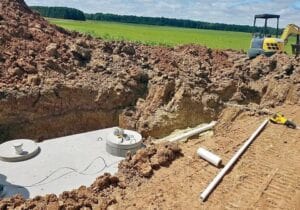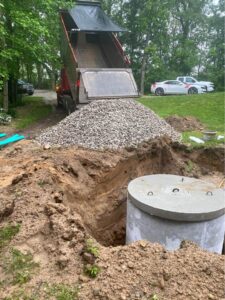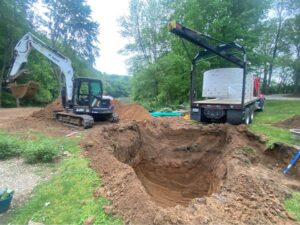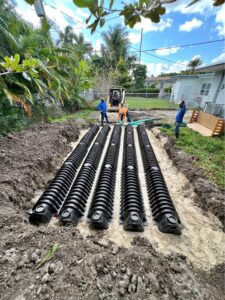Did you know that mobile homes have unique septic tank needs? Mobile homes require special considerations. It’s crucial to comply with regulations for mobile home septic systems to ensure proper functionality and avoid potential issues down the line.
Mobile Home Septic Tank Requirements: A Comprehensive Guide
A properly designed septic system offers numerous benefits for mobile homes. Not only does it provide efficient waste management, but it also helps maintain a healthy environment for you and your family. By investing in a well-designed septic system, you can ensure the longevity of your mobile home’s plumbing infrastructure while minimizing the risk of costly repairs.

So, whether you’re moving into a new mobile home or considering upgrading your existing septic system, understanding the specific requirements for mobile homes is essential.
Let’s dive in!
Plumbing in Manufactured Homes: How It Works
Insight into the plumbing system of manufactured homes.
Plumbing in mobile homes operates similarly to traditional homes, but there are a few key differences to consider. Mobile home plumbing systems are designed specifically for these types of dwellings, taking into account their unique characteristics and requirements. Understanding how the plumbing works in manufactured homes can help homeowners and residents maintain their systems effectively.
Understanding the role of vents and traps in mobile home plumbing.
Vents and traps play crucial roles in the plumbing system of mobile homes. Vents allow air to enter the drain lines, preventing water from flowing slowly or creating gurgling sounds. These vents also release sewer gases safely outside the home, ensuring a healthy living environment. Traps, on the other hand, prevent odors and gases from entering the house by trapping a small amount of water within its bend. This water barrier creates a seal that blocks unwanted smells and gases from infiltrating your living space.
Exploring Common Plumbing Issue
While mobile home plumbing systems function similarly to those found in traditional houses, there are certain issues that tend to be more prevalent in manufactured homes due to factors such as age, materials used, and installation methods. Some common plumbing problems experienced by mobile homeowners include:
Clogged drain lines: Over time, drain lines can become clogged with debris or mineral buildup. Regular maintenance and occasional professional cleaning can help prevent this issue.
Leaking pipes: Mobile home pipes are often made of PVC (polyvinyl chloride) pipe material which is prone to leaks if not properly installed or maintained.
Water waste drainage: Efficient water waste drainage is essential for any dwelling, including mobile homes. Issues with drainage can lead to backups and potential damage if not addressed promptly.
Faulty traps: Traps may wear out or become damaged over time, resulting in unpleasant odors seeping into the home. Regular inspection and replacement of faulty traps can mitigate this problem.
Inadequate water pressure: Mobile homes may experience lower water pressure due to various factors, such as outdated plumbing systems or problems with the water supply. Consulting a professional plumber can help identify and resolve this issue.
By understanding these common plumbing issues, mobile homeowners can take proactive measures to prevent them and ensure their plumbing systems are in good working order.
You might be interested in our article: Fixing Mobile Home Plumbing

Determining the Number of Mobile Homes per Septic Tank
Several factors need to be considered. It is crucial to calculate wastewater flow rates accurately and understand the impact of household size on septic tank capacity. Let’s delve into these factors to determine how many mobile homes can be connected to one septic tank.
Factors to consider when determining how many mobile homes can be connected to one septic tank
Total number of occupants: The first step in determining the number of mobile homes per septic tank is considering the total number of individuals residing in each home. This includes both adults and children. A higher occupancy level will result in increased wastewater production, which influences the capacity requirements for the septic system.
Wastewater flow rates: Calculating wastewater flow rates is vital for accurate determination. The flow rate depends on various factors such as water usage habits, appliances, and fixtures within each mobile home. For example, a family that frequently runs dishwashers, washing machines, and showers will generate more wastewater than a smaller household with minimal water consumption.
Septic system permit regulations: Before connecting multiple mobile homes to a single septic tank, it is essential to check local regulations regarding permits and limitations. Some areas may have specific guidelines regarding the maximum number of dwellings allowed per septic system or require additional inspections for larger systems.
Septic field area: The available space for the drain field or leach field should also be considered when determining how many mobile homes can be connected to one septic tank. Each dwelling requires an adequate area for proper effluent absorption and treatment by soil microorganisms before returning it safely into the environment.
Rural versus urban areas: In rural areas where land availability tends to be greater, there may be more flexibility in connecting multiple mobile homes to a septic tank. However, in densely populated urban areas, space constraints and stricter regulations might limit the number of homes that can be connected to a single septic system.
Are you looking for risers to your mobile home septic tank. These risers make it easy to access your septic when it comes time to pump it. Click here to order these in all different sizes.
Importance of calculating wastewater flow rates for accurate determination
Accurately calculating wastewater flow rates is crucial for determining the appropriate capacity of a septic tank when connecting multiple mobile homes. By considering factors such as water usage habits, appliances, and fixtures within each dwelling, it becomes possible to estimate the total volume of wastewater generated. This estimation helps ensure that the septic system can handle the anticipated load without becoming overwhelmed.
Understanding the impact of household size on septic tank capacity
The size of each household directly affects septic tank capacity requirements. Larger families with more occupants will naturally produce more wastewater than smaller households. Therefore, it is essential to consider both current and potential future occupancy levels when determining how many mobile homes can connect to one septic tank. This foresight prevents overloading the system and ensures its longevity.
Advanced Treatment Options for Below-Ground Septic Tanks
Septic tank systems are an essential part of mobile homes, efficiently managing wastewater and ensuring proper disposal. However, traditional septic tanks have their limitations.
Aerobic Treatment Units (ATUs) in Mobile Home Septic Systems
One popular option for enhancing the treatment capabilities of septic tanks is the use of aerobic treatment units (ATUs). These units introduce oxygen into the wastewater, promoting the growth of beneficial bacteria that break down organic matter more efficiently than in traditional anaerobic systems.
The benefits of ATUs in mobile home septic systems are numerous. Firstly, they provide a higher level of treatment compared to conventional septic tanks, resulting in cleaner effluent. This is especially important for mobile homes located near sensitive environments or bodies of water.
Moreover, ATUs can reduce the size requirements for drain fields or leach fields since they produce a higher quality effluent with fewer contaminants. This compact design makes them particularly suitable for mobile homes with limited space availability.

However, it’s important to note some limitations as well. ATUs require regular maintenance and monitoring to ensure optimal performance. These units may consume more energy due to the continuous operation of pumps and blowers that supply oxygen to the system.
Alternative Treatment Options: Sand Filters or Constructed Wetlands
Apart from ATUs, there are alternative treatment options available for below-ground septic tanks in mobile homes. Two notable examples are sand filters and constructed wetlands.
Sand filters utilize layers of sand through which wastewater passes before reaching the drain field. The sand acts as a filter medium, trapping suspended solids and providing further treatment through biological processes. Sand filters offer effective removal of pathogens and nutrients while requiring minimal maintenance.
Constructed wetlands mimic natural wetland ecosystems by creating a shallow, planted area through which wastewater flows. The plants and microorganisms in the wetland help remove contaminants through processes such as filtration, absorption, and microbial degradation. Constructed wetlands can provide efficient treatment while also offering aesthetic benefits to the surrounding landscape.
Both sand filters and constructed wetlands present alternative treatment options that can enhance the performance of septic tank systems in mobile homes. However, it’s crucial to consider factors such as site suitability, maintenance requirements, and local regulations when choosing these advanced treatment technologies.
Cost Factors: Size and Requirements of Mobile Home Septic Tanks
Installing a septic tank for a mobile home involves various factors that can influence the overall cost. Understanding these factors is crucial in planning your budget and ensuring that your septic system meets the specific needs of your mobile home. Let’s delve into the key considerations that affect the cost of mobile home septic tanks.
Factors influencing the cost of installing a septic tank for a mobile home
Size requirements: The size of your mobile home plays a significant role in determining the cost of installing a septic tank. Larger homes require larger tanks, which naturally incur higher costs. Consider both the number of bedrooms in your mobile home and the number of occupants when determining the appropriate tank size.
Soil conditions: The composition and condition of the soil on your property can impact installation costs. If you have rocky or hard-to-penetrate soil, additional excavation work may be required, increasing labor expenses. On the other hand, if you have sandy or well-draining soil, it may reduce installation costs due to easier digging.
Accessibility: The accessibility of your property also affects pricing. If your site is challenging to reach or requires special equipment to transport materials, it can add extra costs to the installation process.
Location: The location where you plan to install your septic tank influences pricing as well. Different regions may have varying regulations and permitting requirements that can impact costs. If utilities or existing structures obstruct access to certain areas on your property, it may increase installation expenses.
Understanding how size requirements affect pricing
The size requirement for a mobile home septic tank depends on several factors such as local regulations, water usage patterns, and absorption area needs:
Local regulations: Consult with local authorities or health departments to determine any specific requirements regarding minimum tank sizes for mobile homes.
Water usage patterns: Consider the number of occupants in your mobile home and their water usage habits. More people typically mean higher water consumption, which may necessitate a larger septic tank.
Absorption area needs: The size of the absorption area, also known as the drain field or leach field, is directly related to the septic tank size. It should be proportionate to ensure proper wastewater treatment and prevent system overload.
To estimate the appropriate tank size for your mobile home, consult with a professional septic system installer who can assess your specific needs based on these factors.
Additional considerations that may impact overall costs
Apart from size requirements, several other factors can influence the total cost of installing a septic tank for a mobile home:
Type of tank: Different types of septic tanks are available in the market, including concrete, fiberglass, and plastic. Each type has its own price range and installation requirements.
Additional components: Depending on local regulations and site conditions, you may need to install additional components such as distribution boxes or effluent filters. These extra elements contribute to overall costs.
Maintenance requirements: Consider long-term maintenance costs when budgeting for a mobile home septic system. Regular pumping and inspection are necessary to ensure optimal performance and avoid costly repairs.
By considering all these factors during the planning phase, you can develop an accurate budget for installing a septic tank that meets both your immediate needs and long-term expectations.

Frequency of Septic Tank Pumping: Maintenance Guidelines
Determining how often a mobile home septic tank should be pumped is crucial for its proper maintenance. Neglecting this responsibility can lead to costly repairs or even system failures. Several factors come into play when considering the pumping frequency, including household size and water usage habits.
Regular maintenance of your septic tank is essential to prevent overflow and keep it functioning optimally. While there isn’t a one-size-fits-all answer to how often you should pump your septic tank in a mobile home, some general guidelines can help you make an informed decision.
Factors Influencing Pumping Frequency
-
Household Size:
-
The number of people living in the mobile home directly affects the amount of wastewater generated daily.
-
Larger households tend to produce more wastewater, which means that their septic tanks may require more frequent pumping.
-
A family of four might need their tank pumped every three to five years, while a couple living alone could extend it up to seven years between pumpings.
-
-
Water Usage Habits:
-
Excessive water usage can overload the septic system and shorten the time between pumpings.
-
Activities such as long showers, running multiple loads of laundry daily, or leaving faucets running unnecessarily increase water consumption.
-
Conserving water by fixing leaks promptly and adopting mindful water usage practices can help prolong the time between pumpings.
-
-
Tank Size:
-
The size of your septic tank plays a significant role in determining pumping frequency.
-
Smaller tanks have limited capacity and may require more frequent pumpings compared to larger ones.
-
If your mobile home’s septic tank has a smaller capacity, consider scheduling more frequent inspections and pumpings.
-
Check out our article: Water Leak Under a Mobile Home
Importance of Regular Maintenance
Regularly maintaining your septic tank is vital to avoid potential issues that can arise from neglect. By adhering to the following maintenance guidelines, you can prevent costly repairs and ensure the longevity of your system:
-
Pumping Schedule:
-
Establish a pumping schedule based on household size, water usage habits, and tank capacity.
-
Consult a professional to determine the optimal frequency for your specific circumstances.
-
Keep records of past pumpings to help track when the next one is due.
-
-
Inspections:
-
Regularly inspect your septic system for signs of damage or leaks.
-
Look out for foul odors, slow drains, or gurgling noises as these may indicate underlying issues.
-
Schedule professional inspections every few years to assess the overall condition of your septic tank.
-
-
Proper Waste Disposal:
-
Avoid flushing non-biodegradable items such as wipes, feminine hygiene products, or grease down the drain.
-
Dispose of chemicals properly and refrain from pouring them into sinks or toilets as they can disrupt the bacterial balance in your septic tank.
-
By following these maintenance guidelines and taking proactive measures, you can extend the life of your mobile home’s septic tank while minimizing the risk of expensive repairs or system failures. Remember that regular pumping and responsible maintenance are essential for keeping your septic system running smoothly.
DHEC Laws and Regulations for Mobile Home Septic Tanks
The Department of Health and Environmental Control (DHEC) has established a set of laws and regulations to ensure the proper functioning and maintenance of septic systems, specifically targeting those installed in mobile homes. These guidelines are crucial for protecting public health and the environment. Let’s delve into the key aspects of DHEC regulations for mobile home septic tanks.
Overview of Relevant Laws and Regulations
To maintain consistent standards across different regions, DHEC has developed comprehensive regulations that apply to all septic systems, including those in mobile homes. These regulations aim to safeguard water quality, prevent contamination, and promote safe living conditions.
Mobile home owners must adhere to these local regulations when installing or maintaining their septic tanks. These guidelines outline specific requirements related to tank size, drainfield design, setback distances from wells or property lines, soil suitability assessments, permits, inspections, and more.
Compliance Requirements Specific to Mobile Home Septic Systems
There are several key considerations that homeowners need to be aware of:
-
Tank Size: The capacity of the septic tank should be appropriate for the number of occupants in the mobile home.
-
Drainfield Design: The design and layout of the drainfield must comply with specific criteria outlined by DHEC guidelines.
-
Setback Distances: The distance between the septic system components (tank, drainfield) and certain features like wells or property lines must meet minimum setback requirements.
-
Soil Suitability Assessment: A soil evaluation is necessary to determine if the site is suitable for a septic system installation.
-
Permits and Inspections: Obtaining permits from local authorities is essential before installing a new septic system or making modifications. Regular inspections are required to ensure ongoing compliance.
Consequences of Non-Compliance with DHEC Regulations
Failure to comply with the DHEC regulations for mobile home septic tanks can have serious consequences. These include:
-
Health Risks: A non-compliant septic system may pose health hazards due to improper waste treatment and potential contamination of groundwater sources.
-
Environmental Impact: Inadequately maintained septic systems can lead to the release of harmful pollutants into nearby water bodies, causing ecological damage.
-
Legal Issues: Non-compliance with DHEC regulations can result in fines, penalties, or even legal action being taken against the homeowner.
To avoid these repercussions, it is essential for mobile home owners to familiarize themselves with local regulations and ensure their septic systems meet all requirements set forth by DHEC.
Conclusion: Mobile Home Septic Tank Requirements
In summary, septic systems in mobile homes offer both advantages and disadvantages. Understanding how plumbing works in manufactured homes is crucial for proper maintenance and troubleshooting. Determining the number of mobile homes per septic tank ensures efficient waste management. Advanced treatment options for below-ground septic tanks can enhance system performance.
Cost factors such as size and requirements of mobile home septic tanks should be considered when planning for installation or replacement. Following maintenance guidelines, including regular pumping, is essential to prevent system failures and costly repairs. Familiarizing yourself with DHEC laws and regulations pertaining to mobile home septic tanks is important to ensure compliance.
In conclusion, septic systems in mobile homes require careful attention to ensure their effectiveness and longevity. By considering the pros and cons discussed above, you can make informed decisions about your own system.
Call-to-action: If you are a mobile homeowner or considering purchasing a mobile home, it is crucial to understand the ins and outs of septic tank systems. Consult with professionals in the field to assess your specific needs and requirements. By taking proactive measures, you can enjoy hassle-free waste management while ensuring the health and safety of your household.
FAQs: Mobile Home Septic Tank Requirements
Q: How often should I pump my septic tank?
A: It is generally recommended to have your septic tank pumped every 3-5 years, depending on its size and usage. Regular pumping helps prevent clogs, backups, and potential damage to your system.
Q: What happens if I don’t maintain my septic system?
A: Neglecting regular maintenance of your septic system can lead to various issues such as sewage backups, foul odors, groundwater contamination, and even complete system failure. Proper maintenance is vital for the longevity and functionality of your system.
Q: Can I install an advanced treatment option for my mobile home’s septic tank?
A: Yes! Advanced treatment options like aerobic systems or sand filters can enhance the treatment process and improve the effluent quality. Consult with a professional to determine if these options are suitable for your specific needs.
Q: Are there any regulations I need to follow regarding mobile home septic tanks?
A: Yes, each state may have different laws and regulations regarding mobile home septic tanks. It is important to familiarize yourself with your state’s Department of Health and Environmental Control (DHEC) guidelines to ensure compliance.
Q: How can I determine the size of septic tank needed for my mobile home?
A: The size of the septic tank required depends on factors such as the number of bedrooms in your mobile home, daily water usage, and soil conditions. Consulting with a professional can help you determine the appropriate size for your specific needs.
Q: Can multiple mobile homes share a single septic tank?
A: Yes, it is possible for multiple mobile homes to share a single septic tank. However, it is crucial to consider factors such as the total number of occupants and their water usage to ensure that the system can handle the load effectively.
Q: What are some signs that my septic system may be failing?
A: Signs of a failing septic system include slow drains, foul odors inside or outside your home, sewage backups, lush patches of grass near the drain field, or gurgling sounds coming from plumbing fixtures. If you notice any of these signs, it is important to have your system inspected by a professional.
Q: Can I perform maintenance tasks on my septic system myself?
A: While some basic maintenance tasks like conserving water and being mindful of what goes down the drains can be done by homeowners themselves, more complex tasks like pumping or repairs should be left to professionals who have the necessary expertise and equipment.
Q: Are there any eco-friendly options available for mobile home septic systems?
A: Yes, there are eco-friendly options available for mobile home septic systems. These may include advanced treatment options that utilize natural processes to further purify the effluent before it is released into the environment. Consult with a professional to explore these environmentally conscious alternatives.
You might also be interested in our articles:
Mobile Home Replacement: Built on Your Land
